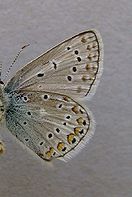Eros blue
| Eros blue | ||||||||||||
|---|---|---|---|---|---|---|---|---|---|---|---|---|

Eros bläuling ( Polyommatus eros ) |
||||||||||||
| Systematics | ||||||||||||
|
||||||||||||
| Scientific name | ||||||||||||
| Polyommatus eros | ||||||||||||
| ( Ochsenheimer , 1808) |
The Eros-Bläulinge ( Polyommatus eros ) is a butterfly ( butterflies ) from the family of the Bläulinge (Lycaenidae). The specific epithet is derived from Eros , the god of love from Greek mythology .
features
butterfly
The species is characterized by a pronounced sexual dimorphism . With a wingspan of around 24 to 28 millimeters, the Eros blue-winged moths are one of the smaller types of blue-blue. Typical of the males is their bright azure blue to turquoise blue color. The top of the wing has a fine, black edge line and white fringes on the outer edges. The clearly protruding veins in the submarginal region are characteristic . The upper side of the wings of the females is brown, partly covered with blue, especially in the basal region . The male butterflies lack edge points on the upper side of the hind wings, whereas the females show a narrow row of points. Both sexes have a light brown to gray-brown colored underside of the wing and some lightly bordered black spots as well as several orange colored spots in the submarginal region. The basal region is lightly dusted blue.
Caterpillar
Adult caterpillars are yellow-green in color and hairy red-brown. They show a dark back line, which is bordered by two yellow lines. The side lines are also yellow in color.
Similar species
- The blue grouse ( Polyommatus icarus ) usually shows a basic color tending to slightly violet-blue in the males and has a darker color on the undersides of the wings.
- In the silver-green blue ( Polyommatus coridon ) the male butterflies shimmer slightly silvery. The undersides of the wings are slightly darker in color and have a different arrangement and intensity with regard to the spots and points. Both sexes are also slightly larger than those of eros .
distribution and habitat
The main distribution area of the Eros-Bläulings are the Alps , the Pyrenees , the Apennines , the Balkan Mountains and mountainous regions in Turkey and Northwest and Central Asia . The animals can be found predominantly at altitudes above 1800 meters. The preferred habitat are flower-rich grass slopes in the mountains.
Way of life
The moths fly in one generation from July to September and like to suckle on moist places on the ground, especially the males. The caterpillars initially feed on the leaves of various lower plants, for example silk moor pointed keel ( Oxytropis halleri ), alpine pointed keel ( Oxytropis campestris ), alpine horn clover ( Lotus alpinus ) or tragacanth species ( astragalus ). The caterpillar then lives myrmekophil with the ant species Myrmica gallienii or Formica lemani together in symbiosis . The caterpillars are dragged into their burrows and fed by the ants. In return, they release a sweet juice that the ants like to lick up and provide them with carbohydrates . The young caterpillars overwinter.
Danger
The Eros-Bläuling occurs in Germany only in the Bavarian Alps , can occur locally there in large numbers and is listed on the Red List of Endangered Species as a species with geographical restrictions.
swell
literature
- Tom Tolman, Richard Lewington: The butterflies of Europe and Northwest Africa . Franckh-Kosmos, Stuttgart 1998, ISBN 3-440-07573-7 .
- Walter Forster , Theodor A. Wohlfahrt : The butterflies of Central Europe. Volume 2: Butterflies. (Rhopalocera and Hesperiidae). Franckh'sche Verlagshandlung, Stuttgart 1955, DNB 456642188 .
Individual evidence
- ^ Arnold Spuler: The butterflies of Europe . tape 1 . E. Schweitzerbartsche Verlagbuchhandlung, Stuttgart 1908, p. 64 .
- ↑ Walter Forster, Theodor A. Wohlfahrt: The butterflies of Central Europe. Volume 2: Butterflies. (Rhopalocera and Hesperiidae). Franckh'sche Verlagshandlung, Stuttgart 1955, DNB 456642188 .
- ↑ a b Tom Tolman, Richard Lewington: The butterflies of Europe and Northwest Africa . Franckh-Kosmos, Stuttgart 1998, ISBN 3-440-07573-7 .
- ↑ Federal Agency for Nature Conservation (Ed.): Red List of Endangered Animals in Germany . Landwirtschaftsverlag, Münster 1998, ISBN 3-89624-110-9 .
Web links
- Lepiforum eV taxonomy and photos
- www.schmetterlinge-deutschlands.de Endangerment
- Polyommatus eros at Fauna Europaea

